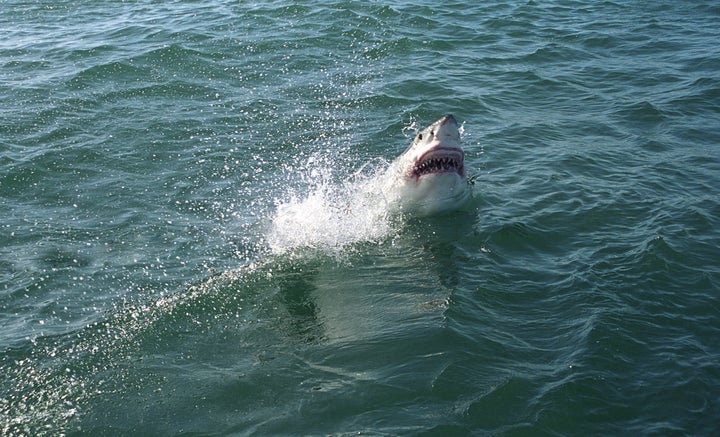
Since the release of Jaws in 1975, with the specter of the man-eating great white shark forever imprinted in our collective imagination, we've been wading into the water a bit more tentatively. But it is, in fact, the sharks that need to worry, particularly those in the waters just off the west coast of the United States. These famous white sharks spotted up and down the California coast are reputed to be some of the largest in the world, and they are in dire straits.
With scientific estimates of fewer than 350 adult great white sharks and a significantly smaller number of reproductively capable females, this genetically distinct population is staring down extinction. As we've said before, we should be scared for sharks (rather than scared of them) and we should be really scared for this irreplaceable population of white sharks.
That's why news this week that NOAA Fisheries -- the federal agency that regulates fishing in our seas -- is considering the species for protection under the Endangered Species Act comes as such a welcome, if overdue, development. The announcement comes in response to petitions filed by Oceana, the Center for Biological Diversity and Shark Stewards, and WildEarth Guardians.
Over the last 30 years, Southern California fishermen have voluntarily reported catching white shark pups in gillnets, however, the full extent of this incidental bycatch in California and Mexico remains unknown. Gillnets pose a unique threat to the future of this population of great whites, as these massive mesh walls used to target halibut, white seabass, thresher sharks and swordfish regularly scoop up multiple juvenile great whites -- whose survival is essential for the continued existence of these animals. The solutions are to ramp up independent observer coverage of these fleets, put in place reasonable, precautionary management to cap and reduce this bycatch, and ultimately further our scientific understanding of great white sharks.
This iconic, ecologically critical group of animals is on the precipice. A single man-made or natural catastrophe could be enough to permanently extirpate them. The alarm bells are ringing and we need to take action now to address the bycatch of great white shark pups in West Coast fisheries.
The loss of the great white shark from the West Coast would not be an isolated tragedy. As research is just starting to uncover, the loss of an apex predator in a marine ecosystem can have cascading, unpredictable and ecologically-devastating consequences. It is therefore in the fishing industry's own best interest to make sure that the great whites stick around. Without a natural predator to keep seal and sea lion populations in check, there could be devastating consequences to commercially and recreationally valuable species of fish like rockfish and salmon. Ultimately, a healthy food web is in everyone's best interest, and great whites are an essential component.
Despite its ubiquity in popular culture, the great white, and the Northeastern Pacific great white, as this population of white sharks is known in scientific literature, is remarkably poorly understood. Scientists believe that since venturing from Australian waters during the Pleistocene 200,000 years ago, the West Coast population has been isolated, becoming both genetically and behaviorally distinct from the rest of the world's great white populations. Scientists are only beginning to understand the peculiar migrations from the California Coast to the Hawaiian Islands to the so-called White Shark Café, an area of open ocean more than a thousand miles from shore where the animals congregate every year. The "Café" was discovered only 10 years ago. What happens there remains largely a mystery to scientists, as it is still unclear whether they are feeding or breeding there. But what we do know about their biology is discouraging for their future prospects. Great whites are slow growing and give birth to few young, making their conservation even more urgent.
Within the next year, NOAA Fisheries will conduct an in-depth analysis of the Northeastern Pacific great white shark population and make a final determination whether to list it as threatened or endangered. If Oceana's petition is successful and these great whites are added onto the Endangered Species List, they would, as a result, need to be granted greater protections from gillnets and other human threats. These protections could include transitioning these fisheries to cleaner fishing methods that are less likely to catch the juvenile great whites, increasing observer coverage to ensure that we know how many sharks are being caught, setting hard caps, or limits, on the amount of white sharks that can be caught as bycatch and creating protected areas for white sharks.
Sharks have been around for almost a half a billion years. The idea that the great white shark could go extinct on the West Coast in the coming decades is obscene. Let's hope NOAA Fisheries ultimately makes the right decision.